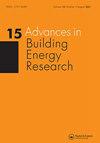A novel machine learning-based framework for mapping outdoor thermal comfort
IF 2.5
Q2 CONSTRUCTION & BUILDING TECHNOLOGY
引用次数: 1
Abstract
ABSTRACT Rapid urbanization and global warming have increased heat stress in urban areas. This in turn makes using indoor space more compelling and leads to more energy consumption. Therefore, paying attention to outdoor spaces design with thermal comfort in mind becomes more important since outdoor spaces can host a variety of activities. This research aims to introduce a machine learning-based framework to predict the effects of different urban configurations (i.e. different greening configurations and types, different façade materials, and different urban geometry) on outdoor thermal comfort through training a pix2pix Convolutional generative adversarial network (cGAN) model. For the training of the machine learning model, a dataset consisting of 208 coupled pictures of input and output has been created. The simulation of this data has been carried out by ENVI-met. The resulting machine learning model had a Structural Similarity Index (SSIM) of 96% on the test dataset with the highest SSIM of 97.08 and lowest of 94.43 which shows the high accuracy of the model and it could have reached an answer in 3 s compared to the 30-min average time for ENVI-met simulation. The resulting model shows great promise for assisting researchers and urban designers in studying existing urban contexts or planning new developments. HIGHLIGHTS Machine learning use in outdoor thermal comfort assessment has been investigated. Vegetation, urban geometry, surface albedo, and water bodies have been studied parameters. Vegetation and street orientation have the highest and water bodies have the least impact on outdoor thermal comfort. Pix2pix algorithm implementation could create thermal comfort maps with 96% SSIM.一种新的基于机器学习的室外热舒适映射框架
摘要快速的城市化和全球变暖加剧了城市地区的热应激。这反过来又使室内空间的使用更加引人注目,并导致更多的能源消耗。因此,由于户外空间可以举办各种活动,因此关注考虑热舒适性的户外空间设计变得更加重要。本研究旨在引入一个基于机器学习的框架,通过训练pix2pix卷积生成对抗性网络(cGAN)模型来预测不同城市配置(即不同的绿化配置和类型、不同的外墙材料和不同的城市几何形状)对室外热舒适性的影响。为了训练机器学习模型,已经创建了一个由208个输入和输出的耦合图片组成的数据集。ENVI-met对这些数据进行了模拟。所得到的机器学习模型在测试数据集上的结构相似性指数(SSIM)为96%,最高SSIM为97.08,最低为94.43,这表明该模型的准确性很高,与ENVI met模拟的30分钟平均时间相比,它可以在3秒内得出答案。由此产生的模型显示出极大的前景,可以帮助研究人员和城市设计师研究现有的城市环境或规划新的发展。亮点机器学习在户外热舒适性评估中的应用已经进行了调查。植被、城市几何形状、地表反照率和水体都进行了参数研究。植被和街道方向对室外热舒适性的影响最高,水体对室外热舒服性的影响最小。Pix2pix算法实现可以创建具有96%SSIM的热舒适度图。
本文章由计算机程序翻译,如有差异,请以英文原文为准。
求助全文
约1分钟内获得全文
求助全文
来源期刊

Advances in Building Energy Research
CONSTRUCTION & BUILDING TECHNOLOGY-
CiteScore
4.80
自引率
5.00%
发文量
11
 求助内容:
求助内容: 应助结果提醒方式:
应助结果提醒方式:


